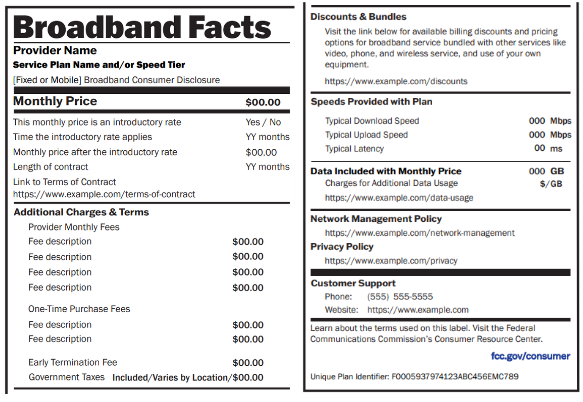New Broadband Transparency Labels Roll Out Nationwide
Government officials express optimism that the introduction of labels will signal a new era of transparency and competition.
Jericho Casper

WASHINGTON, April 10, 2024 – Consumers will begin seeing new broadband pricing and service transparency details at the point of sale for broadband internet services Wednesday, whether online or in-store.
Federal regulations requiring internet service providers to display easy to understand broadband consumer labels came into effect for large ISPs on April 10. Providers with 100,000 or fewer subscriber lines will have until October 10.
The labels aim to facilitate comparison shopping by showcasing important price and performance metrics regarding internet service plans, including introductory rates, data allowances, network performance, privacy policies, latency, and more.
“If you've ever shopped for home or mobile internet, you know how difficult it can be to understand what you're actually paying for,” Jon Donenberg, deputy director of the White House National Economic Council, said during a Tuesday press call. “Confusing fees, obscure terms, and fine prints can make it hard to find the true cost of an internet plan.”
The Federal Communications Commission issued a mandate in November 2022 requiring ISPs to display the labels. The directive stemmed from the Bipartisan Infrastructure Law, which gave the commission one year to establish regulations requiring the display of the labels.
Additionally, it directed the commission to conduct a series of public hearings to assess how consumers evaluate broadband service plans, and determine if current broadband disclosures adequately support informed decision-making.
“The FCC borrowed the nutrition label model format from food products because we wanted to make basic information about broadband internet service easily recognizable and easy to understand,” Alejandro Roark, bureau chief of the FCC Consumer & Governmental Affairs Bureau, said Tuesday.
“A label must be displayed and cannot be buried in multiple clicks or reduced to a link, thumbnail or icon that a consumer might miss,” Roark said.
According to FCC representatives, consumer complaints will serve as the primary source for identifying potential violations of the new requirement. The FCC’s Enforcement Bureau will monitor consumer complaints and public reporting to investigate compliance with the law.
Representatives speaking Tuesday emphasized their commitment to closely monitoring implementation and publicizing these efforts to empower consumers to notify the commission of any potential issues.
Certain ISPs including Verizon and Google Fiber introduced their labels out ahead of the April 10 deadline.
“We didn’t think that Google Fiber customers should have to wait for that clarity,” Ariane Schaffer, the company’s Government Affairs & Public Policy Manager, wrote of the broadband nutrition labels.
Consumers face ongoing challenges in informed decision-making
Despite the introduction of consumer broadband labels, experts and industry insiders speaking at the Broadband Measurement Summit on March 7 underscored the ongoing challenge consumers face in making informed decisions about broadband services.
Panelists noted that the broadband labels operate under the assumption that consumers have a range of options in selecting broadband providers, which they said is often not the case.
In a separate panel discussion, it was suggested that additional improvements to consumer broadband labels could improve the clarity and accessibility of the information they intend to provide.
Panelists pushed for a single, comprehensive price point to be displayed on the label, meeting consumers' demand for transparency regarding fees and taxes.
Experts speaking at a recent Broadband Breakfast Live Online Event expressed split opinions regarding the impact the consumer broadband labels will have.
Individuals participating in the discussion questioned the labels' comprehensiveness, while others raised concerns about potential confusion they might introduce. Additionally, many raised doubts about ISPs' preparedness to create these consumer labels.
Some argued that within the context of today's information overload, ISPs may see these labels as another bureaucratic task from Washington D.C., likely to be met by consumers with little interest.
However, some have emphasized that the labels offer a genuine chance for smaller providers to showcase their services.
At the virtual Broadband Breakfast Live Onoline event, it was noted that smaller Tier 2 and Tier 3 operators are enthusiastic about the chance to level the playing field. They argue that many Tier 1 competitors frequently under-provision services in the market, whereas Tier 2 and 3 fiber operators often over-provision services to ensure quality service and maintain advertised speeds for their subscribers.
The effectiveness of the labels will become apparent as they are rolled out today and beyond.
Government agenda for transparency and competition
Representatives from the FCC and the White House maintain that these efforts will usher in a heightened level of transparency, enhance competition, and empower consumers.
“There's a comprehensive strategy that the administration is pursuing to make sure that every single person in the country can get access to broadband internet that's affordable and accessible,” Donenberg said Tuesday.
“There are a number of components to that: there are transparency measures like the broadband nutrition label. There are enormous, groundbreaking investments in infrastructure through things like the [Broadband, Equity Access and Deployment] program, and there are consumer supports like the [Affordable Connectivity Program].”
“They all work together, and they all work better when they are all in place.”










Member discussion